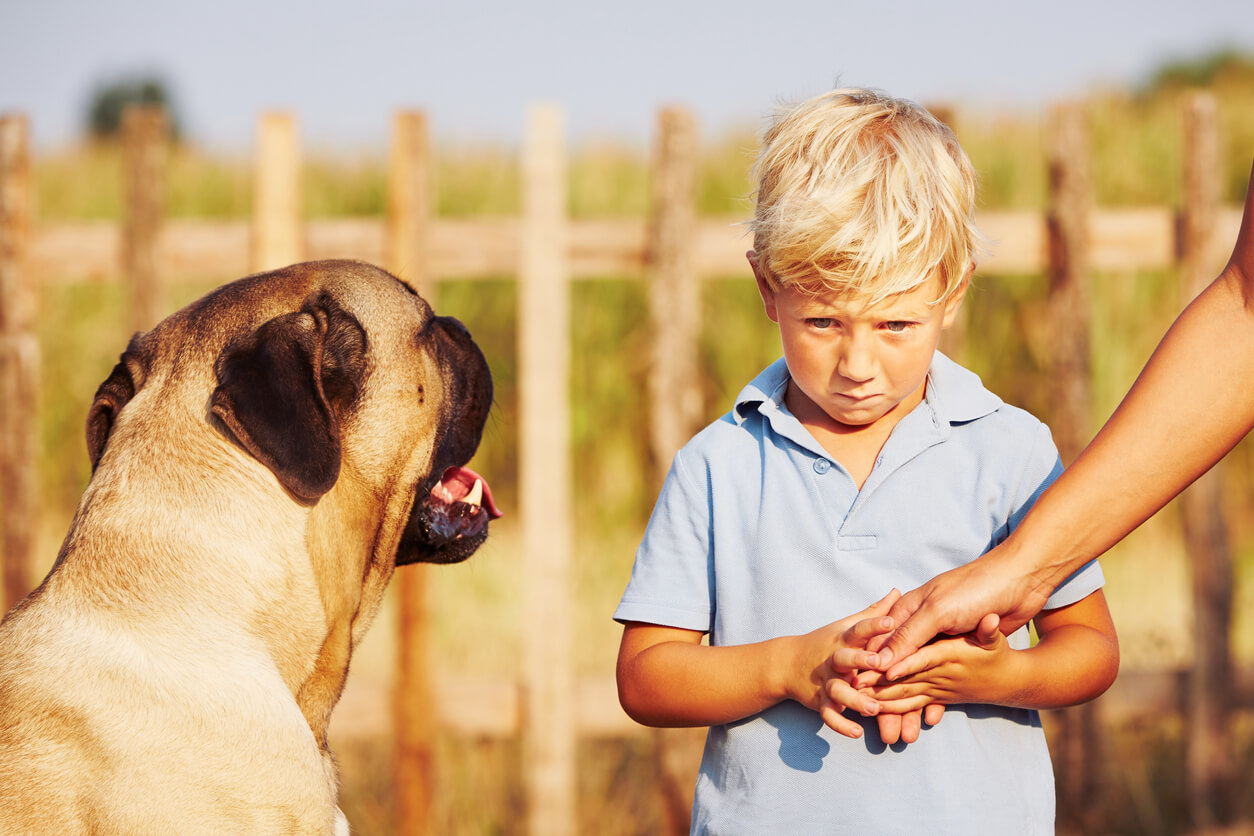How Can I Help My Child Overcome Their Fear of Dogs?


Written and verified by the psychologist Sharon Capeluto
Many little ones have a deep adoration for pets. In fact, we know that the relationship between a child and a dog can be most close and meaningful. They often become best friends. Sometimes their presence even takes on a therapeutic significance. However, in other cases, children experience a fear of dogs.
Just because a child’s afraid of dogs, it doesn’t necessarily mean that they don’t like them. Generally, they’re afraid that these furry animals will come brutally close to them, jump on them, or try to bite them. This concern often leads them to become paralyzed when they cross paths with a dog in the street.
Fear of dogs
There’s no single cause that explains the fear of dogs in children. It can be a fear of the unknown, of having lived some traumatic or uncomfortable experience before, or of receiving an upbringing based on overprotection. The reason isn’t always obvious.
At the same time, it’s important to differentiate between a fear of dogs and a dog phobia. While the former refers to a controlled and non-limiting fear, in the latter case, we’re talking about a more complex situation. A child with cynophobia presents an excessive fear of these animals that’s accompanied by considerable anxiety. In this situation, it’s important to seek advice from a specialist in child psychology.

1. Respect their fear of dogs
This first suggestion applies to any fear that children may feel. In fact, it applies to any other emotion. It’s essential that adults validate everything that children feel, even if it seems irrational or inconsistent to us.
Under no circumstances can we allow ourselves to make fun of them or ridicule their situation. In this regard, making use of their fear to threaten, punish, or manipulate them is a highly damaging measure. Saying phrases such as “If you don’t behave in the park, I’ll make that dog come after you” or “That dog will bite you if you keep yelling” leads to very harmful consequences.
2. Accompany them to expose him little by little
Sometimes, children have the desire to approach a dog they see at a relative’s or friend’s house or simply on the street, but they don’t dare to do so. In these cases, a mixture of contradictory sensations emerges: They like and are attracted to the dogs, but they’re afraid that they’ll do something bad to them.
Gradual exposure is the best alternative to overcome such fear. There’s no point in forcing the child to approach, pet, or play with an unfamiliar dog. On the contrary, the best results are obtained by a gradual connection. At first, you can suggest observing a familiar dog from a distance. Little by little, your child’s confidence will increase and they’ll be encouraged to go for more.
3. Show them how to approach a dog
Interaction with animals has its peculiarities. In principle, the lack of verbal language in dogs can confuse people, because it’s not as easy to interpret them. For this reason, if your child’s afraid, it’s important that they know how to approach them. That is, with slow, cautious movements, always in front of the animal, allow the animal to smell them.

4. Make sure you don’t feed into their fear
It’s not surprising that children who have fearful parents are also fearful. The way we relate to the world is transmitted through actions and not so much through words. Therefore, if your child notices that you’re an insecure person and that you perceive danger where there is none, they’ll absorb that feeling of being at risk.
Accompany, encourage, and guide the child
If your child’s fear of dogs is within the expected parameters, as parents you can accompany the child and help them to overcome the problem. In this regard, we should encourage them to approach progressively so that they can soon interact with the animal. To do this, it’s essential to give the child time and that the adult feels comfortable in the presence of the dog in order to guide this approach.
Many little ones have a deep adoration for pets. In fact, we know that the relationship between a child and a dog can be most close and meaningful. They often become best friends. Sometimes their presence even takes on a therapeutic significance. However, in other cases, children experience a fear of dogs.
Just because a child’s afraid of dogs, it doesn’t necessarily mean that they don’t like them. Generally, they’re afraid that these furry animals will come brutally close to them, jump on them, or try to bite them. This concern often leads them to become paralyzed when they cross paths with a dog in the street.
Fear of dogs
There’s no single cause that explains the fear of dogs in children. It can be a fear of the unknown, of having lived some traumatic or uncomfortable experience before, or of receiving an upbringing based on overprotection. The reason isn’t always obvious.
At the same time, it’s important to differentiate between a fear of dogs and a dog phobia. While the former refers to a controlled and non-limiting fear, in the latter case, we’re talking about a more complex situation. A child with cynophobia presents an excessive fear of these animals that’s accompanied by considerable anxiety. In this situation, it’s important to seek advice from a specialist in child psychology.

1. Respect their fear of dogs
This first suggestion applies to any fear that children may feel. In fact, it applies to any other emotion. It’s essential that adults validate everything that children feel, even if it seems irrational or inconsistent to us.
Under no circumstances can we allow ourselves to make fun of them or ridicule their situation. In this regard, making use of their fear to threaten, punish, or manipulate them is a highly damaging measure. Saying phrases such as “If you don’t behave in the park, I’ll make that dog come after you” or “That dog will bite you if you keep yelling” leads to very harmful consequences.
2. Accompany them to expose him little by little
Sometimes, children have the desire to approach a dog they see at a relative’s or friend’s house or simply on the street, but they don’t dare to do so. In these cases, a mixture of contradictory sensations emerges: They like and are attracted to the dogs, but they’re afraid that they’ll do something bad to them.
Gradual exposure is the best alternative to overcome such fear. There’s no point in forcing the child to approach, pet, or play with an unfamiliar dog. On the contrary, the best results are obtained by a gradual connection. At first, you can suggest observing a familiar dog from a distance. Little by little, your child’s confidence will increase and they’ll be encouraged to go for more.
3. Show them how to approach a dog
Interaction with animals has its peculiarities. In principle, the lack of verbal language in dogs can confuse people, because it’s not as easy to interpret them. For this reason, if your child’s afraid, it’s important that they know how to approach them. That is, with slow, cautious movements, always in front of the animal, allow the animal to smell them.

4. Make sure you don’t feed into their fear
It’s not surprising that children who have fearful parents are also fearful. The way we relate to the world is transmitted through actions and not so much through words. Therefore, if your child notices that you’re an insecure person and that you perceive danger where there is none, they’ll absorb that feeling of being at risk.
Accompany, encourage, and guide the child
If your child’s fear of dogs is within the expected parameters, as parents you can accompany the child and help them to overcome the problem. In this regard, we should encourage them to approach progressively so that they can soon interact with the animal. To do this, it’s essential to give the child time and that the adult feels comfortable in the presence of the dog in order to guide this approach.
All cited sources were thoroughly reviewed by our team to ensure their quality, reliability, currency, and validity. The bibliography of this article was considered reliable and of academic or scientific accuracy.
- Bados López, A., & García Grau, E. (2011). Técnicas de exposición.
- Mateus Sáenz, A. (2019). TUMU, Material de apoyo análogo-tecnológico tipo consola para tratamiento cognitivo conductual de fobia específica, en contexto lúdico para niños de 5 a 9 años que se encuentren asistiendo a una terapia psicológica. Caso de estudio: Cinofobia o Miedo a los perr
- Olivares, P. J. O., Fernández, N. S., & Regadera, M. S. (2017). Evaluación y tratamiento en un caso de cinofobia. Análisis y modificación de conducta, 43(167), 1-18.
- Talegón, M. I., & Paricio, C. G. (2008). Miedo y fóbias en perros. Argos: Informativo Veterinario, (97), 60-61.
This text is provided for informational purposes only and does not replace consultation with a professional. If in doubt, consult your specialist.








